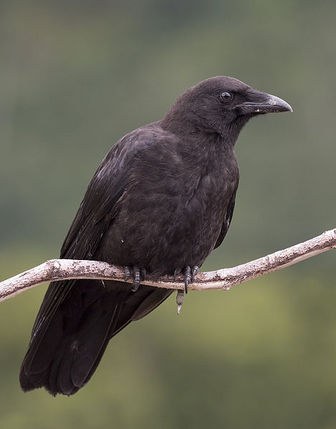Northwestern crow
This species was described by Spencer Fullerton Baird in 1858.

Original source: Own work
Author: Ianaré SéviThis image was selected as a picture of the day for 14 November 2009(2009-11-14). It was captioned as follows:
The Northwestern crow is classified as Least Concern. Does not qualify for a more at risk category. Widespread and abundant taxa are included in this category.
The Northwestern Crow lives along the coastal strip of the northeast Pacific from Alaska to northwestern Washington. Clearing of forest along the coast and rivers has led to an expansion of its historic range, and its adaptable nature has made it a common feature of the urban landscape. Very similar in appearance to the American Crow (Corvus brachyrhynchos), this species is smaller and has a lower-pitched voice. More
The Northwestern Crow (Corvus caurinus) is an all-black passerine bird of the crow genus native to the northwest of North America. It is very similar to the more western forms of the widespread American Crow (Corvus brachyrhynchos) but it is slightly smaller (33-41 cm in length) and has proportionately smaller feet with a slightly more slender bill. It is the calls that are significantly different and often serve to identify it. More
The Northwestern Crow has large range reaching up to 400,000 square kilometers. This bird can be found in Canada and the United States and demonstrates a preference for a wide range of habitats. It appears in forest and marine locations, including sea cliffs and offshore islands, but also appears in heavily populated urban areas as well. The global population of this bird is estimated to be around 1,400,000 individuals. More
A small crow of the northern Pacific Coast, the Northwestern Crow is becoming quite at home in urban areas as well as along the shore. It is smaller than the American Crow and has a more nasal call, but it is so similar that the two may in fact be the same species. More
Northwestern Crows prepare to take peanuts discarded on lawn. Note mottled appearance of fall molt. When not molting, plumage is a uniform, glossy black. Northwestern Crows on snow showing typical plumage. Northwestern Crows taking pieces of bread. Advisory sign posted during nesting season of Northwestern Crow in Sidney, British Columbia. Northwestern Crow on Sidney Town Hall lawn. Northwestern Crow with handout food. A Northwestern Crow, already fed, awaits more. More
Similar species: The Northwestern Crow is distinguished from American Crows by its smaller size, smaller feet, faster wing-beat and lower-pitched voice. A small crow seen incoastal Oregon is not necessarily a Northwestern Crow; it is more likely to be a small subspecies of American Crow. The Northwestern Crow is distinguished from the Common Raven, whose range also overlaps, by its much smaller size, less powerful bill, squarish (instead of wedge-shaped) tail, and absence of shaggy throat feathers. More
seen in coastal Oregon is not necessarily a Northwestern Crow; it is more likely to be a small subspecies of American Crow. Distinguished from Common Raven, which also overlaps range of Northwestern Crow, by much smaller size, less powerful bill, squarish instead of wedge-shaped tail, and absence of shaggy throat-feathers. Differs from Fish Crow (which does not overlap range of Northwestern Crow) by slightly larger size and slightly heavier and larger bill. Click here to compare crows to other black-colored birds. More
believe that the Northwestern Crow is not a true species, but a subspecies of the American Crow. back to top Pictures - back to top Habitat - Northwestern Crows are typically associated with tidal areas. More
The northwestern crow is a seashore predator of marine invertebrates, and birds’ eggs and chicks along the Pacific Coast from Washington to southern Alaska. The crow is found mostly around human habitation but it also occurs along beaches and on seabird islands. There have been no systematic censuses of northwestern crows but Verbeek and Butler (1999) indicated that the North American Breeding Bird Survey did not show an increase between 1980 and 1995. More
Northwestern crows are well known to scientists for their ability to crack clams on rocks to open the shells. Crows find clams buried in beaches that they transport in their bills to rocks, wharves, paved walkways and roads where the clams are dropped until they break. In a series of ingenious experiments, Howie Richardson and Nico Verbeek (1986) showed that crows were adept at knowing the right size of clam that was worthwhile to crack open. More
Northwestern CrowThis information was scanned from The Birds of British Columbia (Campbell et al.), Volume III, pages 228-235. Volumes I, II and III of The Birds of British Columbia, can be ordered electronically at: orders@ubcpress.ubc.ca from UBC Press in Vancouver, British Columbia.. More
The Northwestern Crow is a slightly smaller version of the American Crow. It also looks very similar to the Common Raven, but is much smaller and has a slender bill and it's tail is squared off as opposed to the raven's tail which is rounded. The two types of crows have very much in common. More
The Northwestern Crow is black with a slight purplish gloss. It is smaller and more slender than the American Crow. Its calls resemble those of the American Crow, but are somewhat hoarse. In tidal marshes Red-winged Blackbirds attack these crows, just as inland blackbirds harass the American Crow. This mobbing behavior distracts the crows from their habitual plundering and prevents them from discovering nests; thus broods of marsh birds remain largely unmolested. More

Original source: MGA73bot2
Author: MGA73bot2
Permission: Some rights reserved

